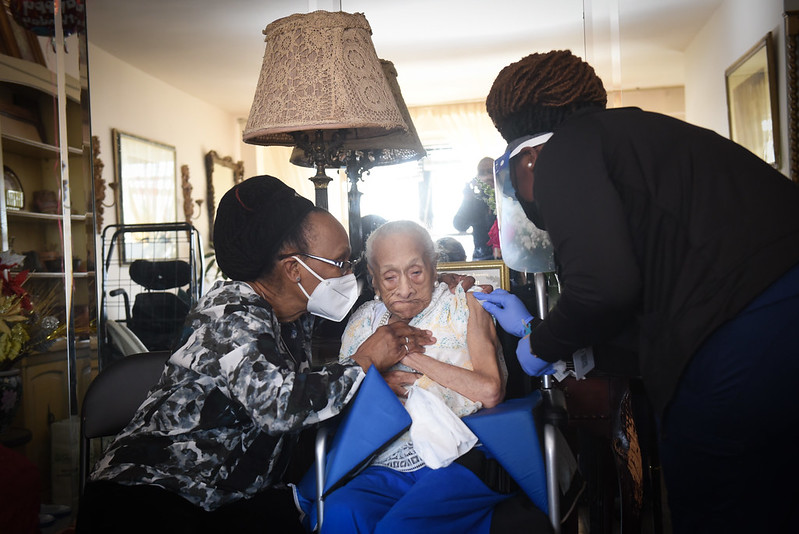
Taking care of people at their homes (photo: Michael Appleton/Mayoral Photography Office)
The rapidly aging population in the United States, combined with the global pandemic, has brought the issue of home care to national headlines. As evidenced by President Biden’s proposal of a standalone $1.8 trillion bill dedicated to caregiving, it’s clear the government is looking to address challenges in long-term care, especially as the sector faces one of its most urgent labor shortages ever. Against the backdrop of Labor Day – a time to celebrate workers and recognize the importance of unions in fighting for better working conditions – there is no better time to reform our home care system for workers and, ultimately, patients.
Today, more than 800,000 individuals remain on the Medicaid waiting list for home care, a number that is only expected to increase in the future. Just consider seven out of 10 of us will need long-term care at some point in our lives. Yet, despite these increases, home care wages have steadily decreased over the last decade. In 2006, home care workers earned approximately 150% of the state minimum wage on average. Today, the same caregivers receive the minimum wage or slightly above. More than one in seven low-wage workers in New York City is a home care worker. One in four workers live below the federal poverty line, and more than half rely on some form of public assistance to make ends meet. These low wages have led to chronic staffing shortages in the industry (17% of home care positions were left unfilled between 2018-2019) and a projected overall workforce shortage crisis of 83,000 workers by 2025.
At the root of this is a systemic devaluation of care work. Traditionally, this labor is undertaken by women, particularly women of color, and government Medicaid reimbursement rates have historically devalued these workers. Home care work is in fact highly skilled work and, as we have seen during this pandemic, often dangerous and heroic. By treating it that way and changing the system accordingly, we can make care work dignified, address the workforce shortage, create a thriving care economy and better serve patients.
In New York State specifically, the two most critical issues in the home care sector are chronic low wages and 24-hour live-in cases, where home care workers stay in patient homes for 24 hours. During this time, workers care for the patient for 13 hours, with the other 11 hours left unpaid for sleep and meals. With approximately 11,000 24-hour cases in New York alone, staffed by 33,000 home care workers, this is an issue that impacts far too many. However, for many in the home care sector, this disparity doesn’t come as a surprise, as nonprofits have historically faced inadequate state compensation, unfunded mandates, and longstanding labor negotiations. In short, state law ties non-profit home care agencies to low Medicaid reimbursement rates and antiquated rules that harm both patients and workers.
The state has continually chosen to ration care rather than allocating the required $1 billion in Medicaid to provide better wages to workers with 24-hour shifts and higher quality care for patients. As CEO of nonprofit organizations that care for 3,000 home care patients and have a 56-year legacy of providing educational, social, and community services for Asian American and immigrant New Yorkers, I understand the impact these outdated policies have on workers, patients, and families alike.
I’m often left wondering: Why did lawmakers create a system that restricts equal pay for equal work? Labor Day is meant to commemorate the contributions workers have made to the strength, prosperity, and well-being of this country – and yet, many of those who care for others are not being cared for by our government.
With the Biden Administration’s long-term vision for home care reform already paving the way for new bills on this issue, we as a community must seize this momentum and end 24-hour shifts. To do so, the New York state government must first create a system by which home care workers receive full compensation for every hour at a patient’s home on call for needed assistance, which starts by transitioning away from 24-hour shifts in favor of two 12-hour split shifts. However, no single entity can make this change alone.
Together, we can put enough pressure on officials in Albany to pass one bill -- A3145, sponsored by Assemblymember Harvey Epstein -- that would end 24-hour shifts in favor of two 12-hour split shifts, as well as another, Fair Pay for Home Care -- S5374/A6329, sponsored by Senator Rachel May and Assemblymember Dick Gottfried -- to raise home care worker pay to 150% of the highest area minimum wage across the state. Both pieces of legislation would allow for long-term investments in home care workers, so they can provide the best care possible for patients, such as new training structures, restructured certification, mentor programs, and more.
If the COVID-19 pandemic has shown us anything, it’s the critical role healthcare professionals provide during times of significant need. For many years, these essential skilled workers have devoted their time and energy to supporting an increasingly aging population. This Labor Day, it’s time for us all to support them and advocate for meaningful, systemic change to build a more just and caring economy.
***
Wayne Ho is President & Chief Executive Officer of the Chinese-American Planning Council, Inc. On Twitter @cpc_nyc.
***
Have an op-ed idea or submission for Gotham Gazette? Email This email address is being protected from spambots. You need JavaScript enabled to view it.